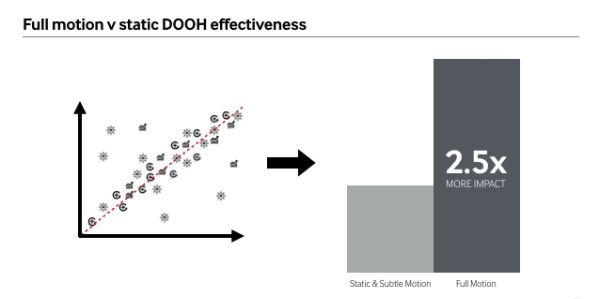
Why Brands Are Turning to Digital Out of Home to Amplify Their Video Advertising

Naturally, we work on the notion that large format full motion digital out of home (DOOH) displays in great locations offer agencies an incredible space in which to work and experiment.
And now that outdoor has moved from static posters to premium displays across multiple cities, there’s no denying the fact that digital out of home is a great way to reach both mobile audiences and those who don’t tend to watch too much TV.
To test the hypothesis that digital out of home can deliver as powerful an emotional response as the best TV ads, Ocean commissioned a new wave of research using brain imaging to explore the neurological impact of digital out of home content on audiences.
Neuro-research was chosen as the best way of exploring impact, because it provides a way of looking at people’s emotional, sub-conscious responses, which are difficult to assess through traditional, questions-based research.
The technology used by our research provider, Neuro-Insight, is known as Steady-State Topography (SST), which records and measures electrical signals within the scalp in order to build a second by second picture of activity in the brain.
Previous studies have established that iconic, large format DOOH advertising delivers heightened emotional response and strong memory encoding.
We also knew that premium sites have a positive priming effect on other OOH advertising and on mobile content.
Our third new study, called Appropriation and Amplification, takes those learnings further to show that full motion content delivers 2.5 more brand impacts over static displays.

Fieldwork was carried out in Manchester where more than 100 participants took a walk past three static and full motion displays showing a variety of different creative executions.
Back in the study room, the participants watched a film of what they have just seen, wearing headsets to record their brain responses to the content on the displays.
The focus was on three key brain response metrics which, in combination, have been shown to correlate strongly with real world effectiveness:
• Peaks in emotional response
• How positive that emotional response was
• The number of brand impacts encoded into memory
The study then benchmarked the responses obtained against television and online video campaigns.
From the resulting responses, the neuroscientists concluded that:
• Both static and full motion content delivers high levels of positive emotional response
• Full motion creative however delivers more branded peaks of memory encoding
• The net impact of these measures in combination equates to a 2.5 stronger impact for full motion digital out of home compared to static
The results also indicate that full motion DOOH has a comparable impact to television and has the capability to build brand equity, rather than just deliver a brand impact.
We also tested short form video to see how it performed in DOOH environments compared to just online.
The results indicate that short-form online video content elicits higher levels of response when delivered via a full motion DOOH screen, and delivers more peaks of branded memory response.
The same piece of content therefore delivers not only targeted activation from the online platform, but also brand building qualities due to the full motion activation.
This means the presence of full motion DOOH alongside an online campaign gives advertisers more opportunities to positively prime the brain to respond strongly to content when it’s viewed subsequently in an online context.
Finally, our findings demonstrate some key characteristics that will help drive high levels of positive brain response to creative content. For example:
• Subtle (not necessarily overt) brand iconography works better than just a plain old logo
• Bright and contrasting colours work really well, but remember to adapt those colours to the environment. A sky background for example won’t register as well on a sky level display.
• And images of people and their faces always deliver a heightened sense of response when viewed in full motion DOOH.
So, we’ve now established that DOOH delivers brain responses that are comparable to that of television advertising and that it works in a similar way, delivering multiple impacts and a strong emotional response: two key components that contribute to driving real world sales which is what our clients require.
And full motion DOOH is a growing vehicle of choice for short-form video because it primes the brain to respond more strongly when the same content is viewed online.
Which means online video campaigns will perform better if full motion DOOH is included in your brand media plan.
If all of this has your brain in a bit of a spin then you can read more about our studies here.
Helen Haines is Head of Marketing & Events, Ocean Outdoor













